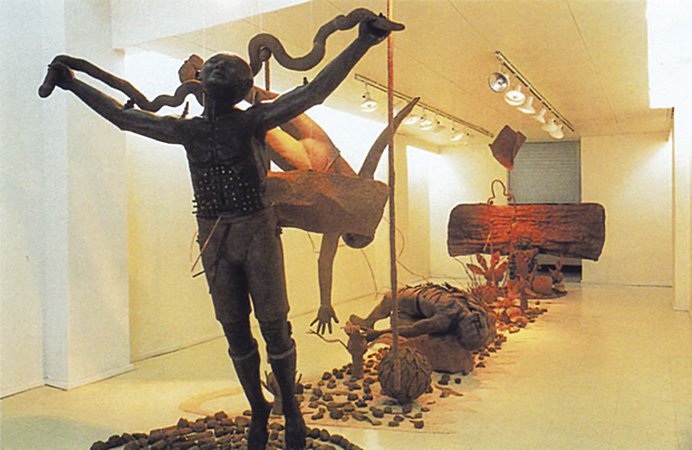Cultural Center of the Philippines
ENCYCLOPEDIA OF
PHILIPPINE ART
Tau-tao
1997 / Installation (sawdust, powdered egg shell, and white glue) / Dimensions variable / Artist: Roberto Feleo / Metropolitan Museum of Manila collection
Roberto Feleo’s Tau-tao series creates a mythopoetic environment of Filipino precolonial and indigenous belief systems and worldviews. Tau-tao’s visual narration is made material through the assemblage of precolonial symbols, objects, and humanlike sculpture that make up Feleo’s installation. The artist visually reinterprets gods, ancestor-spirits, Filipino myths, cosmology, and oral traditions from different Philippine regions. Such are Agtabaynon, a great sea hawk with human body and a character in Bukidnon cosmology; Mebuyan, a female deity with multiple breasts believed to nurture the soul of unborn babies; and the Visayan pintados or precolonial indigenous people with their ornamental and elaborate tattoos.
The Tau-tao displayed at the National Art Gallery of the National Museum, 2008-12, depicts the Bukidnon myth of the afterlife. Feleo created a built environment that enthralls visitors with the mysticism of the cycles of life of Bagobo spirituality. The exhibit featured six life-size human figures representing the six deity characters of Bagobo spirituality and the afterlife. It depicts the transformation of the dead body from decay to ascension. He used sawdust, wood, metal, rocks, and other organic materials to create an immersive site work. He was able to create a process of making art from indigenous pinalakpak, a process of slapping together materials “made of sawdust, water and glue kneaded into a brown mass” (Guillermo 2001, 120-29).
In this artwork, Feleo fuses ethnographic research on the Bagobo community, an ethnolinguistic group living in the southern part of Mindanao, as he visually imagines and creatively translates into visual and tactile form these indigenous oral memories and knowledge. Furthermore, Feleo links the concept of Tau-tao to Philippine cultural traditions, with the practice of placing the dead in secondary vessels, its presence influencing the concerns of the living. His interest in folk memories, indigenous culture, and local mythologies demonstrates an intimacy with our history with the intent of transforming and reconciling deep stories of the Filipino past into a new vision of Filipino shared consciousness.
Written by Clod Marlan Krister V. Yambao
Related Content
Source
Guillermo, Alice G. 2001c. “Roberto Feleo: Connecting Myth and History.” In Image to Meaning. Quezon City: Ateneo de Manila University Press.
